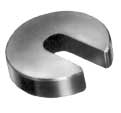
Washers are commonly used to protect parts from the stress of a threaded fastener. They are designed to distribute the load of a threaded fastener, such as a bolt. When you drive a bolt through a part, you’ll expose the part to stress. The underside of the bolt’s head will press against the top of the part. All of that stress concentrated in such a small area may cause the part to crack or otherwise break.
Washers protect parts from damage by distributing the threaded fastener’s load across a larger area. The load will no longer be concentrated to a small area equal to that of the threaded fastener’s head. Instead, the load will spread across the washer, thereby minimizing the risk of damage to the part. While nearly all washers protect parts from stress-related damage such as this, they are available in a variety of styles, such as C washers.
What Are C Washers?
C washers are fastener components that, like most other washers, are designed to distribute the load of a threaded fastener. They provide a greater surface area for the fastener’s load.
C washers receive their namesake from their shape. As shown in the photo above, they are shaped like the letter C. While traditional washers are typically disc-shaped, C washers are crescent or C-shaped.
How C Washers Work
They may look different, but C washers work in pretty much the same way as traditional washers. Rather than driving a bolt directly through a part, you can drive it through a C washer and then the part. The load of the bolt will be distributed across the C washer.
C Washers vs Traditional Washers
So, why should you use a C washer instead of a traditional washer? While most washers are designed to distribute the load of a threaded fastener, C washers are easier to install and remove. If you want to install a traditional washer on a preexisting bolt — meaning the bolt has already been driven through the part — you’ll have to completely remove the bolt. This may or may not be easy depending on the length of the bolt.
You can install a C washer, though, without completely removing the bolt. You just need to loosen the bolt so that a small portion of the shaft is exposed. You can then slide the C washer over the exposed shaft, followed by retightening the bolt.
1
1
